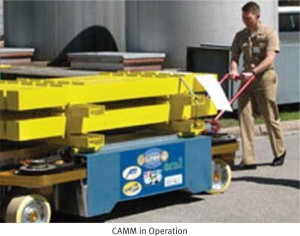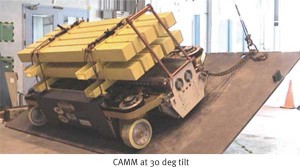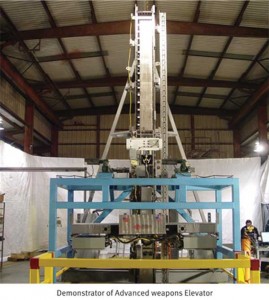 A factor to be considered in gas turbine installations with turbines installed in machinery compartments located deep within the ship is the need for careful routing of the large combustion air downtakes and exhaust gas uptakes, from the upper decks to the turbines, in order to minimize pressure drops and also to avoid interference by the ducts in movement of aircraft on the hangar and flight decks.
A factor to be considered in gas turbine installations with turbines installed in machinery compartments located deep within the ship is the need for careful routing of the large combustion air downtakes and exhaust gas uptakes, from the upper decks to the turbines, in order to minimize pressure drops and also to avoid interference by the ducts in movement of aircraft on the hangar and flight decks.
The British Royal Navy has also selected gas turbines as the main power source for the CVF, after discounting nuclear propulsion on grounds of cost. The installation is a new development which consists of two Rolls Royce MT 30 turbines, each developing 36MW, coupled to high capacity electrical generators, in an Integrated Electric Propulsion (IEP) configuration.
 The turbines are located in sponsons beneath each of the two islands. Electric power is also supplied by 2×11 MW and 2×9 MW diesel generator sets. The ship is propelled by four electric motors, each of 20 MW, two on each shaft which are expected to propel the 65000 tonne ship at speeds of 25+ knots. The propulsion arrangement has been finalized after several iterations, taking into account variable speed requirements for carrier operations and through life costs.
The turbines are located in sponsons beneath each of the two islands. Electric power is also supplied by 2×11 MW and 2×9 MW diesel generator sets. The ship is propelled by four electric motors, each of 20 MW, two on each shaft which are expected to propel the 65000 tonne ship at speeds of 25+ knots. The propulsion arrangement has been finalized after several iterations, taking into account variable speed requirements for carrier operations and through life costs.
The choice of propulsion for an aircraft carrier requires careful consideration of available options, the associated technical risks and the initial as well as through life costs. Once the propulsion plant is finalized, there is no going back, because change of propulsion in mid course would involve prohibitive costs and may well ‘sink’ the project. For situations where the capability and experience of domestic industry in the field of naval propulsion is low, and R&D efforts in this field are limited, selecting propulsion solutions incorporating well proven and matured technologies would be prudent, in order to minimize risk and cost. The Indian Navy’s track record in this regard has been correctly conservative.
Way Ahead
On the other hand, reaching for leading edge technologies would not be out of place in respect of deciding the composition and capabilities of the air wing and the ship’s C4I systems, including the main radars, because these need to defeat the opposition ‘on the day of the match’. Investment in R&D effort in these areas is justifiable. A collaborative approach for development of say, combat systems and even nuclear propulsion with capable and reliable partners, on a cost sharing basis would mitigate technical and financial risk, and therefore merits consideration.
 The process of designing aircraft carriers, as already stated is complex and unless a rigorous and disciplined approach is followed to take timely and rational decisions on key issues the design process gets stalled and solutions would not crystallize. The time frames and issues involved in the design process are presently known to all involved in the IAC-1 project. The decision – making process for the design of IAC-2 would benefit from an early start, with feasibility and costing studies, as well as simulations for complex activities, such as Flight Deck Management, being commissioned as early as possible for deciding key issues.
The process of designing aircraft carriers, as already stated is complex and unless a rigorous and disciplined approach is followed to take timely and rational decisions on key issues the design process gets stalled and solutions would not crystallize. The time frames and issues involved in the design process are presently known to all involved in the IAC-1 project. The decision – making process for the design of IAC-2 would benefit from an early start, with feasibility and costing studies, as well as simulations for complex activities, such as Flight Deck Management, being commissioned as early as possible for deciding key issues.
Rational decisions need to be arrived at on important issues such as aircraft stowage and maintenance, hangar size and the extent of on-board maintenance facilities to be provided. Wherever the availability of new development systems has an element of uncertainty, a ‘Plan B’ must be in place, as a fallback, so that progress in the design and construction is not stalled. The design itself would need to be progressed with an eye on the future, particularly in respect of the next generation air wing, in order to ensure that the carrier remains role-worthy over its designed life.
Besides the issue of design, another important decision would be to finalise the location where the next carrier would be built. Certainly, due consideration needs to be given to the infrastructure already created and the experience gained on IAC-1. Depending on the size of the next carrier, shipyard facilities may need to be augmented, or, alternatively, building at multiple locations may need to be considered. Project management structures, which allow ploughing back of expertise acquired and lessons learnt, and are not subject to loss of continuity also need to be envisaged, employing, if required, ‘out of the box’ approaches. Although the delivery of IAC-1 is still some time away, it is by no means too early to initiate the processes necessary to come to an early decision on the major parameters and way ahead for IAC-2. Considering the magnitude of the project, a dedicated project group could be formed to commence work on this project exclusively, interacting with all stakeholders, and presenting alternative options on all major facets to the Naval Staff, so that convergence is achieved in time on major parameters after rigorous consideration, and the project progresses in an optimum manner.
References
- “French Aircraft Carrier Participation to Afghanistan Operations; Key Lessons Learnt for the Future Aircraft Carrier and her Carrier Air Wing”—Paper presented by RAdm Jean-Louis Kerignard, French Navy at the Annual Maritime Power Conference, 2010, organized by the National Maritime Foundation at New Delhi.
- “Carrier Renaissance: New Wave Designs to Maximise Innovation”--- Bill Sweetman, Janes International Defence Review, Vol 39, October 2006.
- “The Challenges of Evolving a Big Aircraft Carrier- The UK Experience”---Paper presented by RAdm Bob Love, OBE, Royal Navy at the Annual Maritime Power Conference, 2010, organized by the National Maritime Foundation at New Delhi.
- “Two of a Kind: Pragmatism Drives UK Carrier Construction Scheme” --- Richard Scott, Janes International Defence Review, Vol 42, September 2009
- “Challenges of Carrier design and Construction – Limited Budgets”--- Paper presented by Commodore AK Khetan, VSM, Indian Navy at the Annual Maritime Power Conference, 2010, organized by the National Maritime Foundation at New Delhi.
Photo/Illustration acknowledgements
- Concept IAC 1- Indian Navy
- French Carrier Charles de Gaulle – Commander Pascal Carre, French Naval Attache
- INS Vikramaditya – http://in.fittopostblog.com/2010/06/10/waiting-for-ins-vikramaditya
- INS Viraat – http://widescreenstuff.com
- Artist’s impression USS Gerald R Ford – www.navy.mil/navydata/fact_display
- Artist’s impression British CVF HMS Queen Elizabeth II class – http://www.defenceindustrydaily.com
- USS Enterprise – US Navy
- USS Nimitz – http://en.wikipedia.org/file:uss_nimitz
- F 18C on Catapult – www.howstuffworks.com/aircraft-carrier3.html
- EMALS deck view – www.naval-technology.com/projects/cvn-21
- EMALS being assembled – http://media.defenceindustrydaily.com
- Advanced weapon elevator demonstrator–www.magnemotion.com/products/elevators
- CAMM (2 pictures) – http://seabasing.nsrp.org/news/camm_vip_day0706.html





Hanji sir,I am one of your ex-navy LME.Served on board INS kirpan and Udaygiri.If you receive this message pls.contact me.I am a Canadian citizen nowadays.Thanks lot.Dilbagh singh randhawa.1974-1984.